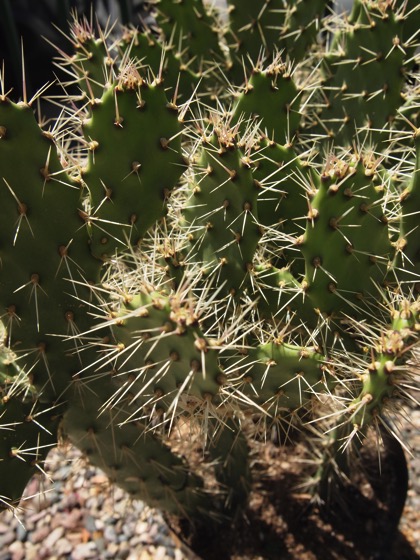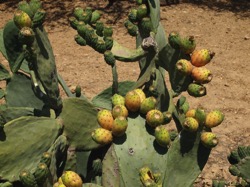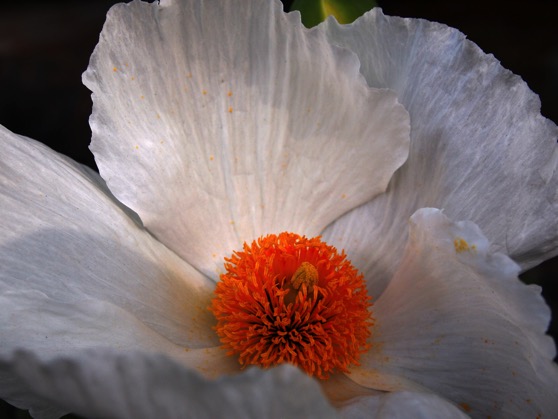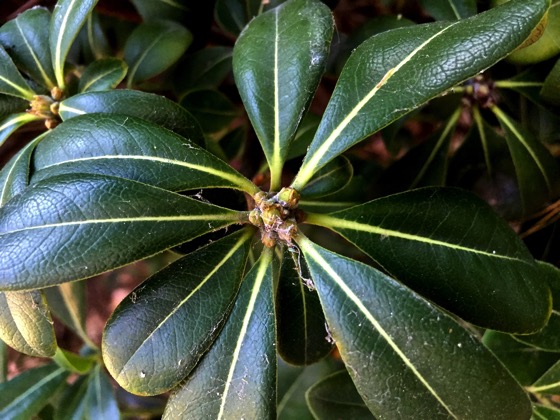In the natural world, flowers get all the attention and I have been guilty of perpetuating that bias here in my own blogs. That said, leaves are amazing, too, so in this series I will highlight the many forms of leaves available out there. — Douglas
Opuntia

These modified paddles and spines might not look like leaves, but they are just that. Opuntia, and other cactus have evolved their leaves into structures that can store moisture in the driest times and spines that can dissuade animals from eating it — a great combination. Some may be put off but the “prickly” nature of cactus, but i find them rather fascinating. So much so, I recently harvested some paddles from a neighbor’s large opuntia (with their permission) and potted them up to root here in my own garden. Once rooted, I have several areas where they will fit nicely into the garden proper.
While Opuntia are native to South America, they had been introduced around the world, including Sicily, where we recently spent a few weeks visiting family. Once day we attended a conference at the Parco dell’Etna on the farming of fico d’India (as they are named in Italian) and ciliege (cherries) on the flanks of Etna. These plants are major food products, both internally to Italy and for export throughout Europe. They even have their own Denominazione di Origine Protetta (literally “Protected Designation of Origin”) meaning they are certified as being locally grown and packaged. This is similar to the DOC and DOCG labels found on Italian wines designating and protecting their origins and name. At this event we tasted the raw, peeled Opuntia fruit, pressed juice and even a Sicilian speciality, prickly pear granita. All where quite delicious and renewed my thoughts of making an opuntia liqueur some time in the future.




Photo; Douglas E. Welch
Opuntia is a genus in the cactus family, Cactaceae.
The most common culinary species is the Indian fig opuntia (O. ficus-indica). Most culinary uses of the term “prickly pear” refer to this species. Prickly pears are also known as tuna (fruit), sabra, nopal (paddle, plural nopales) from the Nahuatl word nōpalli for the pads, or nostle, from the Nahuatl word nōchtli for the fruit; or paddle cactus.
The genus is named for the Ancient Greek city of Opus, where, according to Theophrastus, an edible plant grew which could be propagated by rooting its leaves.[1]
Like all true cactus species, prickly pears are native only to the Americas, but they have been introduced to other parts of the globe. Prickly pear species are found in abundance in Mexico, especially in the central and western regions, and in the Caribbean islands (West Indies). In the United States, prickly pears are native to many areas of the arid Western United States, including the lower elevations of the Rocky Mountains, where species such as Opuntia phaeacantha and Opuntia polyacantha become dominant, and to the desert Southwest, where several types are endemic. Prickly pear cactus is also native to coastal beach scrub environments and low open areas of the East Coast from Florida to Connecticut/Long Island (Opuntia humifusa).
Opuntia species are the most cold-tolerant of the lowland cacti, extending into western and southern Canada; one subspecies, O. fragilis var. fragilis, has been found growing along the Beatton River in central British Columbia, southwest of Cecil Lake at 56° 17’ N latitude and 120° 39’ W longitude.[2] Prickly pears also produce a fruit, commonly eaten in Mexico and in the Mediterranean region, known as tuna; it also is used to make aguas frescas. The fruit can be red, wine-red, green, or yellow-orange.
The first introduction of prickly pears into Australia are ascribed to Governor Philip and the earliest colonists in 1788. Brought from Brazil to Sydney, prickly pear grew in Sydney, New South Wales, where they were rediscovered in a farmer’s garden in 1839. They appear to have spread from New South Wales and caused great ecological damage in the eastern states. They are also found in the Mediterranean region of Northern Africa, especially in Tunisia, where they grow all over the countryside, and aridsouthern Europe, especially on Malta, where they grow all over the islands, in the south-east of Spain, and can be found in enormous numbers in parts of South Africa, where it was introduced from South America.
In Bulgaria, Opuntia cacti were planted on the tiny St. Thomas Island in the Black Sea in 1933 by the royal botanist Ivan Buresh. Since then, they have covered most of the island.[3][4] Further naturalized Opuntia colonies can be found in the Kresna Gorge of the Struma River valley in southwestern Bulgaria, which has a mild, Mediterranean-influenced climate.[5] — Wikipedia
More information on Opuntia:
Previously in Garden Leaves:






